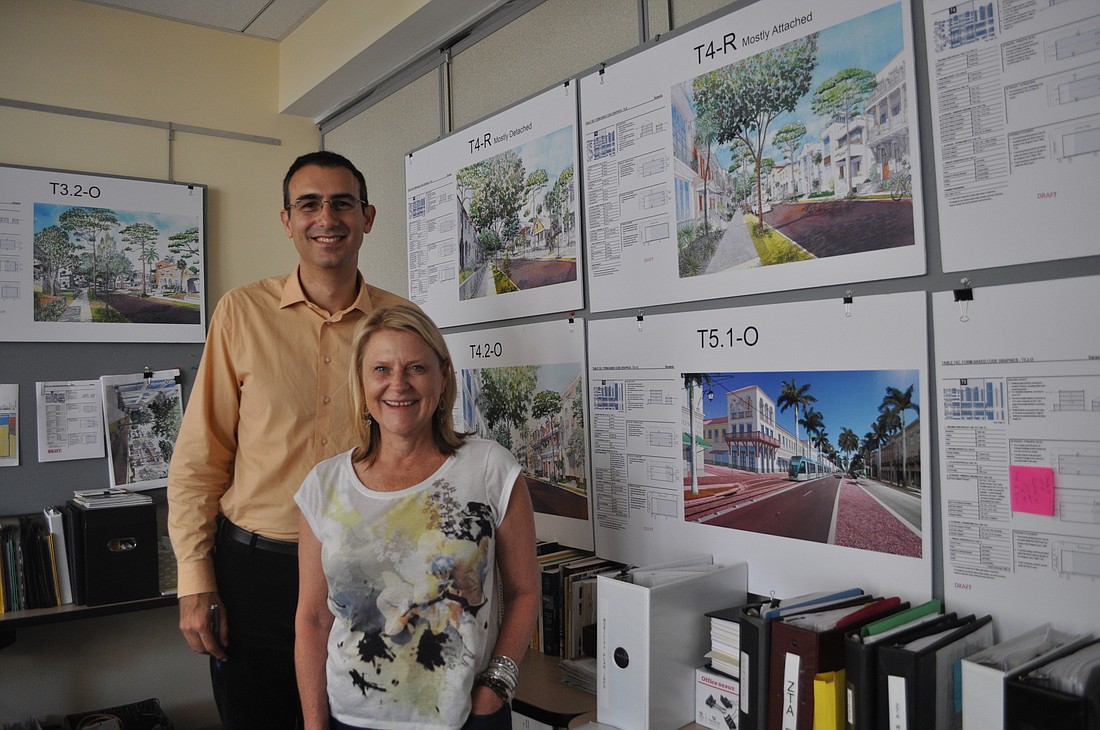- May 8, 2024
-
-
Loading

Loading

As she outlines the principles incorporated into the proposed form-based zoning code for the city of Sarasota, Karin Murphy singles out one of the reasons writing a municipal code can be exciting from a planning perspective.
Murphy, director of the city’s Urban Design Studio and principal author of the new code, is part of a two-person team within the city. But she describes writing a code as a deeply collaborative process within the community of new urbanists, with planners building on one another’s work to create a better product.
“We’re all working on these things,” Murphy said in a January interview with the Sarasota Observer. “Our sign palette was inspired by Cincinnati. We’re going to update it … and we’ll give it to the Center for Applied Transect Studies, so other cities can benefit.”
This month, that sign segment of the form-based code caught the attention of Andrew Georgiadis, who previously worked at the Urban Design Studio before leaving his position with the city in 2015. Reading a draft version of the code on the city’s website, Georgiadis noticed material repurposed from the Cincinnati form-based code.
Rather than an accepted professional practice, Georgiadis saw this as a troubling use of someone else’s work.
“It is not acceptable that a draft be posted on the city website with another firm’s intellectual property contained therein,” Georgiadis wrote in an email to Vice Mayor Shelli Freeland Eddie.
By no means is Murphy attempting to pass someone else’s work off as her own. She cops to using another source for that portion of the code, and points out that material was previously used in the Beaufort, S.C. code — though the same firm worked on the Beaufort and Cincinnati codes. Although it’s not included in the draft version, Murphy is working on an acknowledgement section that will recognize the other documents from which the code draws.
“It’s not uncommon for governments to share things,” Murphy said. “I’ve had planners, while we’re doing our code work, ask to send them things. I said ‘absolutely, use it.’”
Georgiadis said he believes there are distinctions between material designated for reuse — such as the SmartCode, originally created by Miami planning firm Duany Plater-Zyberk & Co. — and work a private firm has contributed to a municipal code.
“That’s a far different matter from taking non-SmartCode content and incorporating it into the code,” he said.
Georgiadis also questioned why the draft code incorporated material from Cincinnati’s building-type section, because he had produced content focusing on the same issue before leaving his position.
“It’s baffling why there would be material from another municipality, when for at least certain parts of the code, there was already tailored material the taxpayers already paid for,” he said.
Brian Falk, director of publications for the Center for Applied Transect Studies, said he wasn’t able to comment specifically on the material used in the Sarasota code. In general, though, he said it wasn’t uncommon for code work to get passed from city to city.
“If the question is whether parts of codes are repurposed for other codes, the simple answer is yes,” Falk said.
Georgiadis also registered his concerns with City Manager Tom Barwin. City spokeswoman Jan Thornburg said it’s standard for municipalities to look at best practices from other municipalities, and the city attorney’s office said there are unlikely to be any intellectual-property issues surrounding materials in a municipal document.
Murphy remains focused on finishing the form-based code for public review. One of the projects the Urban Design Studio is working on is updating the language in the sign chapter to comply with the U.S. Supreme Court decision in the 2015 case Reed v. Town of Gilbert.
Once that work is complete, Murphy said she’d be happy to share the document with person who needs to update a code in the wake of that ruling, which dealt with sign content rather than appearance or size.
“If they want it, we’ll give it to them,” she said.